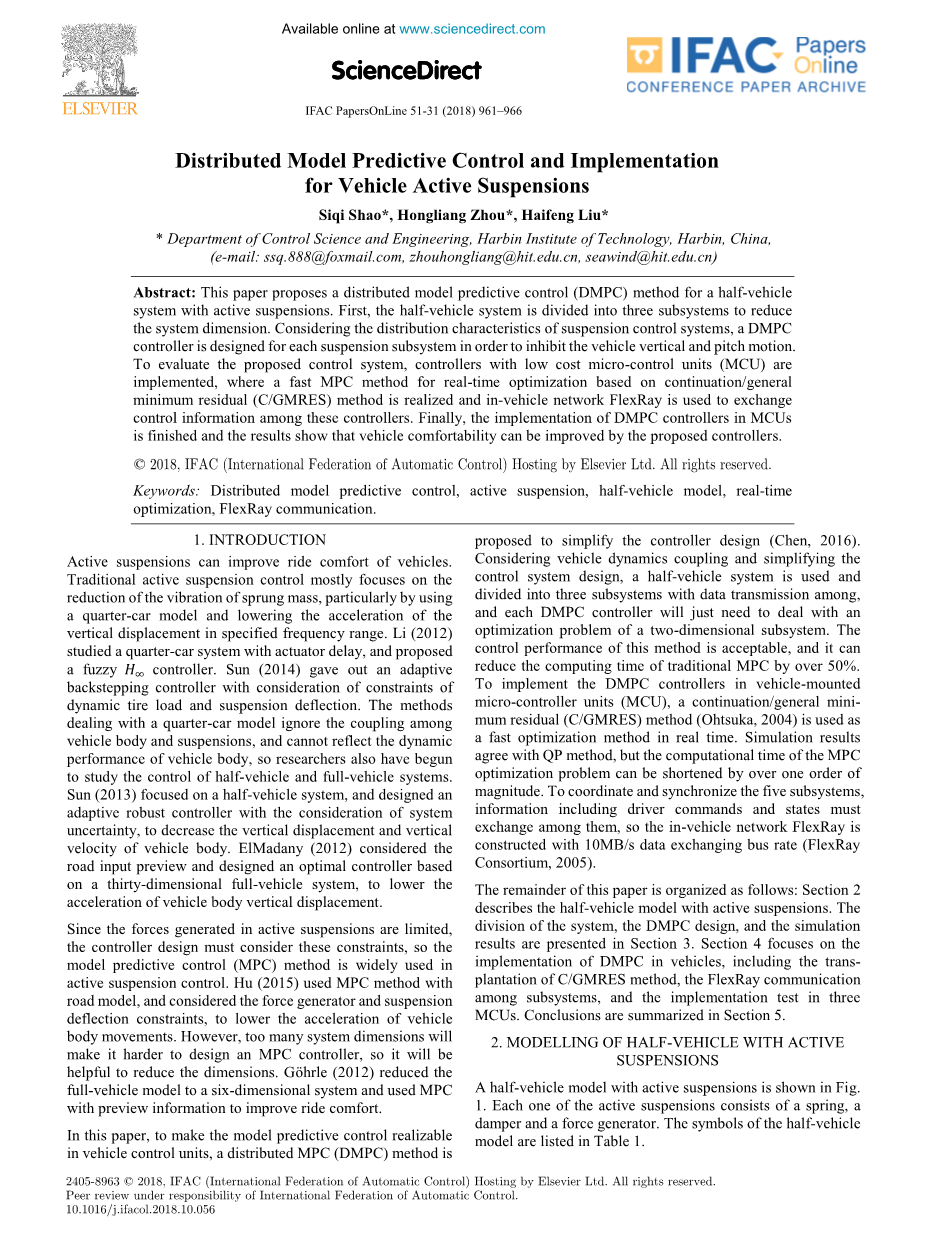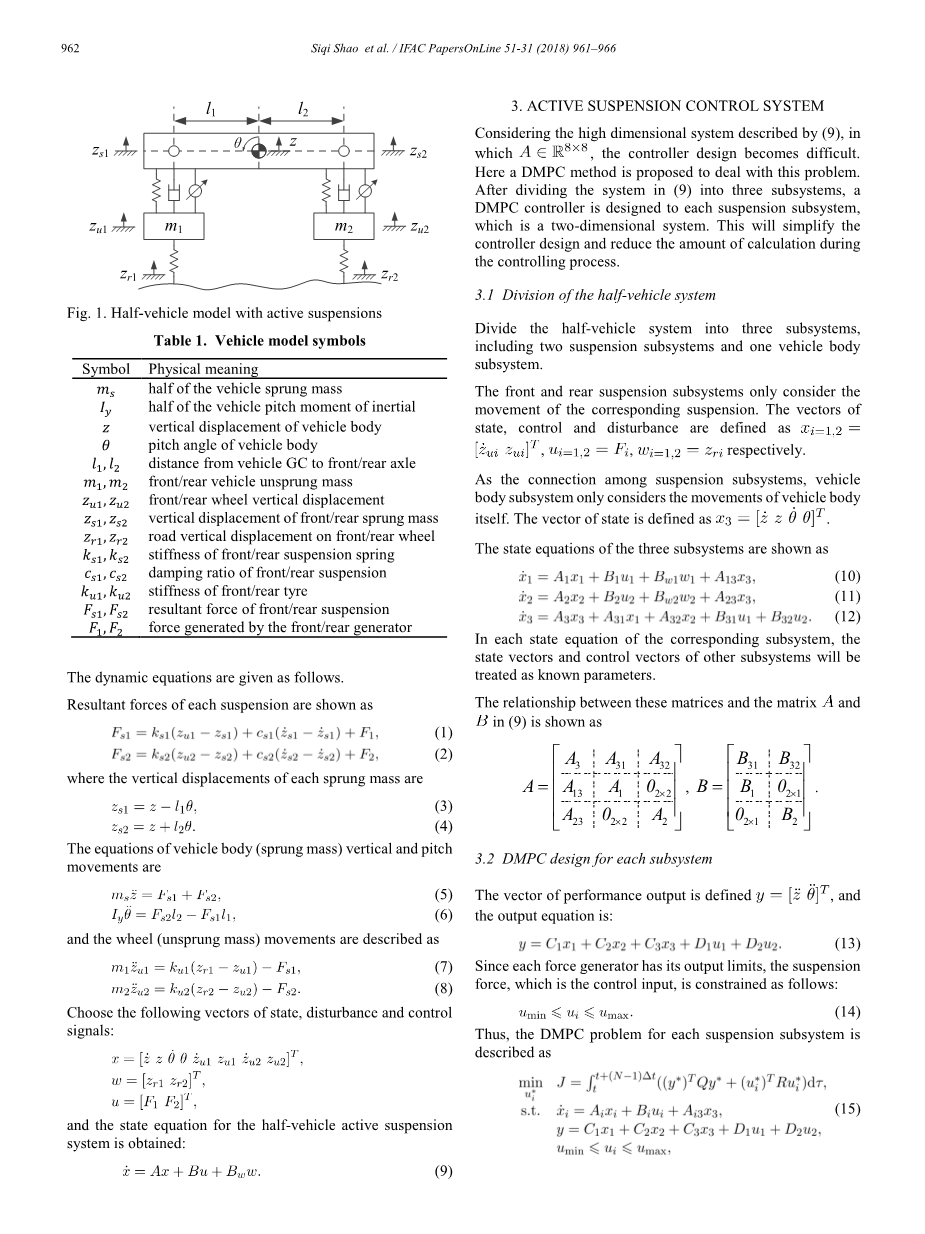

英语原文共 6 页,剩余内容已隐藏,支付完成后下载完整资料
Distributed Model Predictive Control and Implementation for Vehicle Active Suspensions
车辆主动悬架的分布式模型预测控制与实现
Abstract: This paper proposes a distributed model predictive control(DMPC) method for a half-vehicle system with active suspensions. First, the half-vehicle system is divided into three subsystems to reduce the system dimension. Considering the distribution characteristics of suspension control systems, a DMPC controller is designed for each suspension subsystem in order to inhibit the vehicle vertical and pitch motion. To evaluate the proposed control system, controllers with low cost micro-control units (MCU) are implemented, where a fast MPC method for real-time optimization based on continuation/general minimum residual (C/GMRES) method is realized and in-vehicle network FlexRay is used to exchange control information among these controllers. Finally, the implementation of DMPC controllers in MCUs is finished and the results show that vehicle comfortability can be improved by the proposed controllers.
摘要:针对主动悬架半车系统,提出了一种分布式模型预测控制(DMPC)方法。首先,将半车系统划分为三个子系统,减小了系统的维数;针对悬架控制系统的分布特性,设计了一种针对各个悬架子系统的DMPC控制器,以抑制车辆的垂直和俯仰运动。为了对所提出的控制系统进行评估,实现了具有低成本微控制单元的控制器,实现了一种基于延拓/通用最小残差(C/GMRES)方法的快速MPC实时优化方法,并利用车载网络FlexRay在这些控制器之间交换控制信息。最后,完成了DMPC控制器在MCUs中的实现,结果表明该控制器可以提高车辆的舒适性。
Keywords: Distributed model predictive control, active suspension, half-vehicle model, real-time optimization, FlexRay communication.
关键词:分布式模型预测控制,主动悬架,半车模型,实时优化,FlexRay通信
- INTRODUCTION
1. 介绍
Active suspensions can improve ride comfort of vehicles. Traditional active suspension control mostly focuses on the reduction of the vibration of sprung mass, particularly by using a quarter-car model and lowering the acceleration of the vertical displacement in specified frequency range. Li (2012) studied a quarter-car system with actuator delay, and proposed a fuzzy controller. Sun (2014) gave out an adaptive backstepping controller with consideration of constraints of dynamic tire load and suspension deflection. The methods dealing with a quarter-car model ignore the coupling among vehicle body and suspensions, and cannot reflect the dynamic performance of vehicle body, so researchers also have begun to study the control of half-vehicle and full-vehicle systems. Sun (2013) focused on a half-vehicle system, and designed an adaptive robust controller with the consideration of system uncertainty, to decrease the vertical displacement and vertical velocity of vehicle body. ElMadany (2012) considered the road input preview and designed an optimal controller based on a thirty-dimensional full-vehicle system, to lower the acceleration of vehicle body vertical displacement.
主动悬架可以提高车辆的乘坐舒适性。传统的主动悬架控制主要集中在减小簧载质量的振动,特别是采用四分之一车模型,在规定的频率范围内降低垂直位移加速度。Li(2012)研究了1/4车辆系统与执行机构延迟并提出了模糊HHinfin;控制器。Sun(2014)提出了一种考虑动态轮胎载荷和悬架挠度约束的自适应后退控制器。四分之一车模型的处理方法忽略了车身与悬架之间的耦合,不能反映车身的动态性能,因此研究人员也开始研究半车和整车系统的控制。Sun(2013)以半车系统为研究对象,设计了一种考虑系统不确定性的自适应鲁棒控制器,以减小车身的垂直位移和垂直速度。EIMadany(2012)考虑道路输入预览,设计了基于30维整车系统的最优控制器,以降低车身垂直位移加速度。
Since the forces generated in active suspensions are limited, the controller design must consider these constraints, so the model predictive control (MPC) method is widely used in active suspension control. Hu (2015) used MPC method with road model, and considered the force generator and suspension deflection constraints, to lower the acceleration of vehicle body movements. However, too many system dimensions will make it harder to design an MPC controller, so it will be helpful to reduce the dimensions. Gouml;hrle (2012) reduced the full-vehicle model to a six-dimensional system and used MPC with preview information to improve ride comfort.
由于主动悬架产生的力是有限的,控制器的设计必须考虑这些约束,因此模型预测控制(MPC)方法在主动悬架控制中得到了广泛的应用。Hu(2015)将MPC方法与道路模型相结合,考虑了力的产生和悬架挠度约束,降低了车身运动的加速度。然而,太多的系统尺寸会使设计MPC控制器变得更加困难,因此它将有助于减少尺寸。Go h r le(2012)将整车模型简化为一个六维系统,并使用带有预览信息的MPC来改善行驶舒适性。
Considering vehicle dynamics coupling and simplifying the control system design, a half-vehicle system is used and divided into three subsystems with data transmission among, and each DMPC controller will just need to deal with an optimization problem of a two-dimensional subsystem. The control performance of this method is acceptable, and it can reduce the computing time of traditional MPC by over 50%. To implement the DMPC controllers in vehicle-mounted micro-controller units (MCU), a continuation/general mini- mum residual (C/GMRES) method (Ohtsuka, 2004) is used as a fast optimization method in real time. Simulation results agree with QP method, but the computational time of the MPC optimization problem can be shortened by over one order of magnitude. To coordinate and synchronize the five subsystems, information including driver commands and states must exchange among them, so the in-vehicle network FlexRay is constructed with 10MB/s data exchanging bus rate (FlexRay Consortium, 2005).
为了使模型预测控制在车辆控制单元中得以实现,一种分布式MPC (DMPC)方法是第五届IFAC发动机和动力系统控制仿真与建模大会,长春,中国,2018年9月20-22日2016年9月20-22日,中国长春,第五届IFAC发动机与动力总成控制仿真与建模大会考虑车辆动力学耦合,简化控制系统设计,将半车系统划分为三个子系统,各子系统之间进行数据传输,每个DMPC控制器只需要处理一个二维子系统的优化问题。该方法控制性能良好,可使传统MPC的计算时间减少50%以上。为了在车载微控制器单元(MCU)中实现DMPC控制器,采用延拓/通用最小剩余(C/GMRES)方法(Ohtsuka, 2004)作为一种实时的快速优化方法。仿真结果与QP方法一致,但MPC优化问题的计算时间可以缩短一个数量级以上。为了协调和同步这五个子系统,包括驾驶员指令和状态在内的信息必须在这五个子系统之间进行交换,因此FlexRay车载网络采用10MB/s的数据交换总线速率(FlexRay Consortium, 2005)。
The remainder of this paper is organized as follows: Section 2 describes the half-vehicle model with active suspensions. The division of the system, the DMPC design, and the simulation results are presented in Section 3. Section 4 focuses on the implementation of DMPC in vehicles, including the trans- plantation of C/GMRES method, the FlexRay communication among subsystems, and the implementation test in three MCUs. Conclusions are summarized in Section 5.
本文的其余部分组织如下:第2节描述了主动悬架的半车模型
剩余内容已隐藏,支付完成后下载完整资料
资料编号:[236162],资料为PDF文档或Word文档,PDF文档可免费转换为Word


